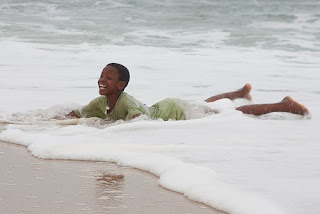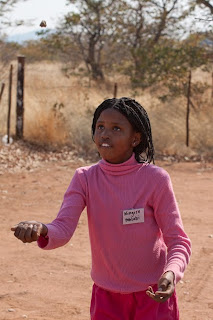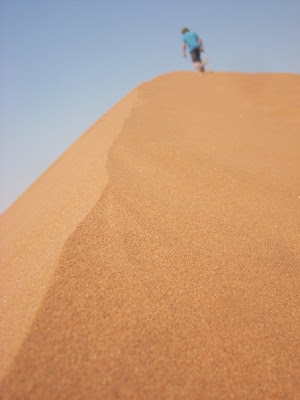The other day I did some calculating and figured that over the course of 21 days during the August-September holiday, I traveled a total of 5645 kilometers, about 3508 miles!
It was an epic trip full of innumerable memorable moments,
so I will try and recount the highest highlights which hopefully will do the journey justice. After a flurry of exam-marking and submitting the final grades for term two, I left the village and headed down to Okahandja to meet the new volunteers. The timing was such, that I had to travel the nine hours south on my birthday, but this time the unpredictable hitch-hiking worked out for the better. A nifty German guy and his Owambo wife picked me up in their van and we made a quick jaunt into Etosha National Park where the giraffes sang me their muted songs of birthday happiness and the twelve Oryx displayed their horns in a show of symbolic birthday candles. The unexpected nature visit, combined with snacks and intelligent conversation, made for quite a unique and fortunate experience. Arriving safely at the training center in Okahandja, I stayed for five days with the brand new arrivals to Peace Corps Namibia, answering questions, weighing in with my experiences so far, and explaining my role as a Volunteer Support Network member. I've been in Namibia for a little over ten months now, so in the eyes of the fresh-off-the-planers, I was sometimes regarded as the all-knowing expert, which is only true relative to their newness. There is always so much more to learn!
And then came Diversity Tour which definitely provided ample learning opportunities for kids and PC volunteers alike. The Diversity Tour is akin to a huge field trip, where 40 of the best learners from schools in all 13 regions of Namibia get to travel with ten lucky PCVs to the far corners of the country. The learners applied for the tour by writing essays about the diversity of gender and the different male/female roles in their cultures. Forty learners were chosen, and were provided transportation to Windhoek where the tour began. The tour is funded through donations from various sources: NGOs, PEPFAR (President's Emergency Plan for AIDS Relief), families and friends of PCVs, etc. In Windhoek, we went to The American Cultural Center; the memorial for war veterans called Heroes' Acre, and had an excellent tour of the international airport. All 50 of us were granted special access to go through security and out onto the tarmac where we watched a plane takeoff and then got to tour the inside of an airplane. The kids were really excited about the movie screens, the complementary blankets, and the barf bags! Some of these learners had never traveled farther than 50 kilometers (or less!) from their village so the capital city, the planes, the different landscapes, and most experiences throughout the next eight days were completely new and eye-opening. At least that was the goal!
We capped off the day in Windhoek with a visit to UNAM, the University of Namibia, which hopefully exposed these kids to the possibilities that exist outside of their rural villages, and inspired them to keep up the hard work in school. It must be said though, that the 40 kids, ranging from grades 6 to 10, were already excellent students, the cream of the crop. We had kids from almost every tribe in Namibia: Kwanyama, Ndonga, Mbalantu, Kwaluudhi, Damara, Nama, Herero, Himba, San, Baster, Tswana, Mbukushu, Subia, Mafwe, and probably more that I'm forgetting. They were required to speak English so as not to create tensions between the kids speaking different home languages. But they were all great and gave us no problems. We basically took every volunteer's favorite, smartest, funniest learner and mixed them together with amazing results. Their English was great, they could think outside the box, solve riddles, tell jokes, and even do math in their heads! As much as I love the kids in my classes at Elamba, it was hard not to wish for a classroom full of these superstars.

The next morning we watched a movie at the cinema and they loaded up on junk food. G-Force was a ridiculous ninety minutes of animated guinea pigs masquerading as FBI agents but the kids loved it and repeated their favorite lines throughout the rest of the trip. Then we spent a day at the coast in and around Swakopmund. The first stop was the snake park where some of the braver individuals got to hold a python. At the aquarium, we saw a scuba diver feeding turtles and sharks along with some prickly rock lobsters. The kids didn't believe that people eat lobsters and recoiled in horror when we told them to reach in the water and take one because it was on the menu for that night's dinner! After romping and climbing all over Dune Seven in the desert heat, the cold foggy beach didn't seem so appealing, but that didn't dissuade the majority of the kids, who jumped right in and frolicked in the waves!



All fabulous photos courtesy of Greg, Parker's friend and fellow PCV
The next morning we had bus trouble which forced us to miss the Cheetah Conservation Society, so instead, we used the spare time to play lots of games and squeeze in some other activities. Throughout the tour we planned various interactive presentations designed to address certain topics such as positive team building, HIV/AIDS education, cultural acceptance, horizon expansion, all with an overarching theme of enjoyment! The Wall and Snap Judgment demonstrated how stereotyping is neither fair nor accurate. Myth-Fact promoted HIV/AIDS awareness and prevention. Sex or Gender addressed the difference between physical characteristics and habitual actions. The Human Knot and Trust Falls stressed cooperation and teamwork. But we also had some games from the pure fun category like Sharks and Minnows (renamed to Lions and Springbok), frisbee, soccer, and a speed-counting game called 7up. The long bus rides were perfect for wordsearches, hangman, riddles and songs. But we began to rue the day that we taught them 'Who stole the cookie from the cookie jar?'! The bus was finally fixed and the next interminable 30 mph drive deposited us right inside the gate of Etosha where we stayed the night. Early in the morning, we began the all-day trip through the park.

Within 5 minutes the ubiquitous springbok, oryx, and zebra were sighted and we couldn't help but see them in droves the rest of the day! For the whole tour, the 40 learners were divided into four teams: Giraffes, Rhinos, Zebras, and Elephants. Colleen and I were the leaders for the giraffes and when the first of our long-necked mascots appeared, the kids on our team went wild, calling out 'My brother! My sister!' And then all of a sudden we came across two huge male lions lounging in the dewy dawn not five yards from the bus! We were stunned by our luck and for a few brief moments, we marveled at their might. Then the bus driver inexplicably started honking the horn and the two maned beasts abruptly rose from their grassy beds and prowled away into to the endless acres of Etosha. This was just one of the many infuriating incidents involving our driver but I won't go into it so as not to ruin the reverie or mar the memories.

We continued on and stopped at Okaukuejo Lodge where there is a man-made watering hole. Jackals, kudu, wildebeests, and ostrich were added to the list. From then on, most animals were hiding from the intense midday heat, so we only chanced upon a few faraway elephants, some scattered giraffes, and the odd ostrich. The next destination was a town called Opuwo in the northwest, and we were given a special permit to exit the west gate of the park where only guided tours are usually allowed. We arrived in Opuwo early enough for a few activities before dinner followed by a screening of the desert episode of Planet Earth which contains several scenes of the Namibian deserts. The next day, we paid a visit to the cattle-centric, bare-breasted, hut-dwelling, ochre-wearing OvaHimba people. They live quite an amazing life and the visit was truly enlightening. Two of the learners on the tour were OvaHimba and it was amazing to see them come out of their quiet shells and answer questions posed by the other learners. Uapiaruka later said how surprised he was by the genuine respectful interest everyone showed in his culture, and it was moments like that that made the whole tour worth it.


That night we showed the inspirational movie Akeelah and the Bee, and had some impromptu spelling contests. The final day of the tour found us clambering about on the boulders and crags of Ruacana Falls. There was hardly a trickle where in May there had been a torrent. We missed out on the spuming spectacle, but instead descended the shaky spindly staircase to the depleted river below. It was probably not the best idea to let all those rambunctious kids loose on the rocks, but a dip in the cool green water was irresistible. Everyone survived with only one girl freaking out on some steep rocks and one scary moment in the water. Kauarive told me he could swim and proceeded to jump in and almost drown me with his clawing arms and adrenaline enhanced strength. But I was able to deliver him safely to the other side thanks to my years of swimming lessons and my equally adrenaline enhanced strength. He wrote me a thank you card later that day be called me his 'hiroe''
That night we had our closing ceremony talent show with all sorts of
acts: songs, dances, dramas, skits and one beautiful poem. David was the oldest learner and won over all the volunteers with his unfailing good humor, his wit, his caring behavior towards the younger kids, and his unequalled maturity and intelligence. He was the perfect role model for the rest of the learners (besides us volunteers of course!). His poem was an excellent metaphor depicting how the water (PCVs) nourished the scattered desert plants (learners from all parts of Namibia) and they grew into one continuous lush flourishing forest. My other favorite was a girl named Ningire who had the greatest laugh and played a shrewd game of hangman. She was a natural with the juggling balls so we did a short performance of some passing tricks we whipped up the previous day. I'm hoping to send her some juggling balls soon.


Geraldine and Kristiana, two of the quietest learners, surprised us all with a stellar duet. Katunavawo passed around some of his amazing drawings of village scenes. The rest of the program was filled with original songs, intricate dramas, and a striking lack of stage fright. After the talent show ended, we handed out certificates and a group picture to everyone for a tangible memento of the successful tour.

Alas, the tour had to end sometime, and the entire next day was spent driving the B1 south to Windhoek, intermittently dropping off learners along the way. Eight or so learners lived too far south to make it home in one day so we overnighted with Shawn, the volunteer who lives in Windhoek. Those lucky few were treated to pizza for the last hurrah and we saw them off in the morning after procuring transport to their respective homes. Thus ended the Diversity Tour, which will definitely be in the top highlights of my two years in Namibia. I'll sure miss those great kids.
But the journey was not over yet...
To see more of Greg's amazing photos and stories here is his blog
http://greginnamibia.blogspot.com/I hope all is well with all of you. I appreciate any and all emails from my dear friends and family. Kaleni po nawa, Parker
pakalewis@gmail.com


















